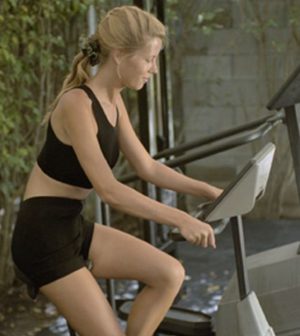- Skip Storing This Everyday Product in the Fridge Door
- Green Tea + B3 Pairing May Boost Brain Health
- Navigating Your Midlife Crisis: Embracing New Possibilities
- City Raccoons Showing Signs of Domestication
- Mapping the Exposome: Science Broadens Focus to Environmental Disease Triggers
- One Week Less on Social Media Linked to Better Mental Health
- Your Brain Changes in Stages as You Age, Study Finds
- Some Suicide Victims Show No Typical Warning Signs, Study Finds
- ByHeart Formula Faces Lawsuits After Babies Sickened With Botulism
- Switch to Vegan Diet Could Cut Your Greenhouse Gas Emissions in Half
Is Interval Training the Fountain of Youth?

High-intensity interval training (HIIT) is an exercise technique done by alternating short bursts of all-out effort in an aerobic activity with periods done at a very slow pace.
HIIT has many benefits, not the least of which is being able to get the results of a regular 30-minute workout with less heavy exertion and making exercise more enjoyable.
Mayo Clinic researchers found an even greater plus. There’s nothing like HIIT to stave off the aging process, thanks to changes it creates at the cell level, effects that can’t be achieved with any kind of medicine. What’s more, as positive as the changes were for younger people studied, they were even greater among people over 65.
Gauging the level of intensity needed for the HIIT intervals isn’t difficult. A person’s maximum aerobic activity (220 minus your age) can be rated on a scale of 0 to 10. High-intensity intervals are done at an exertion level of 7 or higher, around 80% to 95% of your maximum. (As a comparison, moderate activity is 60% to 70%, and vigorous activity is 70% to 80%.)
You can decide on the length of the segments. But, in general, according to the American Council on Exercise (ACE), the high-intensity intervals should last between 30 seconds and 3 minutes. The low-intensity intervals can be anywhere from two to four times as long. While HIIT can be done with any type of aerobic activity, walking on a treadmill, running and cycling are particularly easy to adapt to the sequencing.
Sample HIIT Workout
- Warmup: 5 minutes
- High-intensity activity: 1 minute
- Low-intensity activity: 2 minutes
- High-intensity activity: 1 minute
- Low-intensity activity: 2 minutes
- High-intensity activity: 1 minute
- Low-intensity activity: 2 minutes
- High-intensity activity: 1 minute
- Low-intensity activity: 2 minutes
- Cooldown: 5 minutes
Experts at ACE suggest getting your doctor’s OK first and using the technique for only one or two workouts per week. Note that interval training is not an alternative to strength training for improving muscle strength and mass, so be sure to include both types of exercise in your weekly fitness plan.
More information
The American Council on Exercise has more on HIIT workouts on its website.
Source: HealthDay
Copyright © 2025 HealthDay. All rights reserved.










